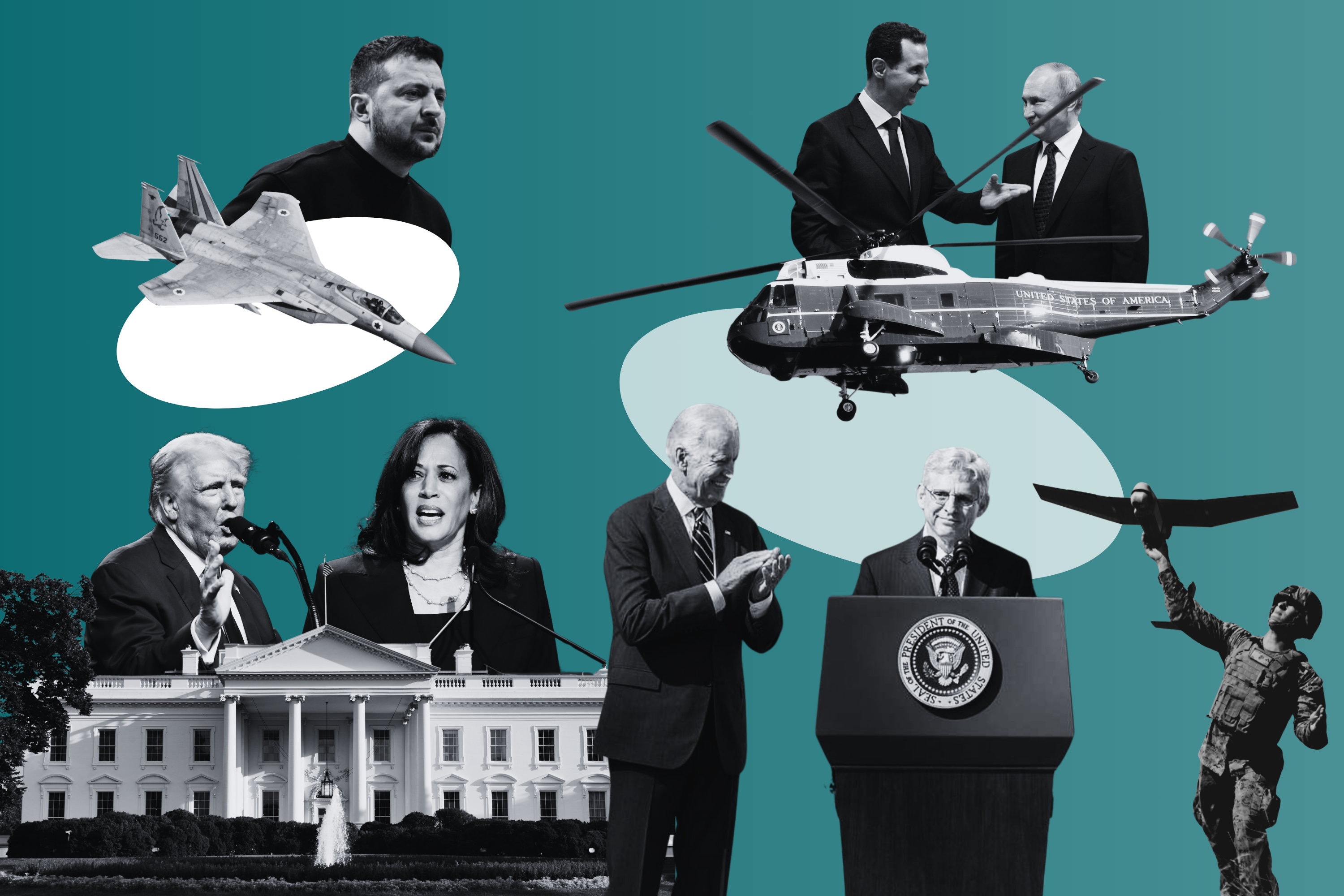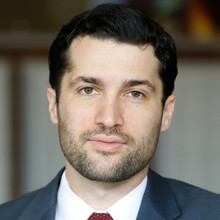The Year That Was (2024)

Published by The Lawfare Institute
in Cooperation With

Yes, 2024 was the year Donald Trump came roaring back, vanquished his prosecutors and the numerous criminal cases against him, and retook the presidency.
But it wasn’t only the year of Trump’s comeback.
It was also a year of war in the Middle East, and another year of grinding war in Ukraine.
It was a year in which the ascent of artificial intelligence went turbo-charged—and in which managing content on major human-run systems remained a deep challenge.
And it was a year in which the international system truly tipped back towards one of major power competition, with all the dangers and challenges that shift entails. The era defined by counter-terrorism is certainly over. The era in which major powers vie for spheres of influence is back with a vengeance.
It was also a year in which issues important on this site but barely discussed elsewhere burst on the national media scene—issues like the security of undersea cables.
It was a year in which unpopular arguments ventilated on Lawfare and ignored elsewhere suddenly found themselves before the Supreme Court—arguments, for example, that the TikTok ban should survive a First Amendment challenge or that the Jan. 6 storming of the Capitol might disqualify Trump from appearing on presidential ballots.
And it was a year in which the issues that have long formed the backbone of Lawfare’s work continued to develop, often beneath the notice of the mainstream press: issues of surveillance law, encryption, the law of armed conflict, foreign relations law, privacy and the management of data, and the continuing fallout of American counterterrorism policies of eras past.
It was a year in which Congress barely managed to function, and yet produced major legislation on TikTok and Ukraine funding even as it fell further and further behind on technology policy issues ranging from privacy to content moderation.
And it was a year in which cybersecurity policy developed both domestically and internationally even as major cybersecurity incidents continued.
In short, it was a long year—and we covered it all. Here’s Lawfare’s editorial team on the major events across the diverse range of the security landscape. It’s The Year That Was: 2024.
We’ll see you next year.
- Benjamin Wittes, Editor in Chief, and Natalie Orpett, Executive Editor
Table of Contents
- Another Year of War in Ukraine (Eric Ciaramella and Anastasiia Lapatina)
- Strategic Competition with Russia and China (Scott R. Anderson)
- Israel's Multi-front War (Dan Byman)
- National Security Action (and Inaction) in Congress (Molly Reynolds)
- Cybersecurity (Eugenia Lostri)
- Artificial Intelligence (Kevin Frazier)
- The Information Ecosystem (Quinta Jurecic)
- Tech Policy (Alan Z. Rozenshtein)
- The Criminal Trials Against Then-Former President Donald Trump (Roger Parloff and Anna Bower)
- Democracy and the Rule of Law (Olivia Manes and Katherine Pompilio)
- Extremism (Dana Stuster)
- Climate Security (Tyler McBrien)
Another Year of War in Ukraine
- Eric Ciaramella, Contributing Editor, and Anastasiia Lapatina, Ukraine Fellow
The past twelve months have been tough for Ukraine. The year began amid a standoff in Congress over President Biden’s request for an emergency supplemental national security package that included $61 billion in urgent economic and military funding for Ukraine’s defenses. Congress finally passed the bill in April, but the delay put Ukraine at a severe disadvantage as Russia pressed ahead on the battlefield and destroyed much of Ukraine’s energy infrastructure. In the final months of his presidency, Biden is spending down this aid package—which includes a variety of legal authorities to provide equipment and training—in an effort to help Ukraine stabilize its front lines. Biden has also reversed his longstanding opposition to allowing Ukraine to use U.S. long-range weapons against targets inside Russia.
Even with these policy moves, Ukraine as of late 2024 is on its back foot. Russia is making steady battlefield gains despite suffering tremendous losses of personnel and equipment. Ukraine’s shocking operation to seize part of Russia’s Kursk region did not reverse Moscow’s momentum, nor did President Volodymyr Zelensky’s decision to swap out his top military commander improve the effectiveness of Kyiv’s overall strategy. At the same time, Ukraine faces severe manpower shortages, a growing source of discord between Kyiv and Washington.
Meanwhile, Zelensky has struggled to gain international support for his Victory Plan—especially from President-elect Trump, who has given contradictory signals about his willingness to continue U.S. military support. Curiously, some Ukrainians still hold out hope that Trump’s unpredictability will work in Kyiv’s favor after years of what they see as Biden’s excessive caution. We analyzed the unexpected sources of Ukrainian optimism.
Ukraine’s long-term security arrangements have been a major topic of Lawfare scholarship this year. As NATO allies debated whether to invite Ukraine to join the alliance, we proposed a policy framework centered on a legally binding long-term U.S. commitment to arm, train, and support Ukraine. Months later, on the margins of the NATO summit in Washington, Biden and Zelensky signed a ten-year security agreement that sparked a spirited Lawfare debate, with one analyst arguing that the document was weak and signaled a lack of U.S. resolve and another arguing that, with improvements, it could serve as the first step toward a long-term security framework while NATO membership remains uncertain.
Lawfare also spotlighted the complex legal and policy debates about using Russia’s immobilized central bank assets to fund Ukraine’s defenses. We offered a menu of options for U.S. lawmakers to consider, focusing on ways to mitigate legal and economic spillover effects. In April, Congress adopted the REPO Act, giving the President the authority to confiscate these assets. Several Lawfare contributors analyzed the legislation and the risks associated with implementing it. The White House has yet to act on the new law, largely due to concerns from fellow G7 members. Instead, the G7 crafted an innovative mechanism to sidestep these concerns by using the windfall proceeds from the assets to fund a $50 billion loan.
Strategic Competition with Russia and China
- Scott R. Anderson, Senior Editor
Underlying many of the more high-profile conflicts and developments of 2024 was the continuation of a broader geopolitical trend: a growing policy focus on strategic competition between the United States and other major powers, specifically China and Russia. At Lawfare, we not only covered the more obvious consequences of this increased competition—like the war in Ukraine and maritime tensions in the South China Sea—but some of its less documented permutations as well, from competition over AI and other emerging technologies to Chinese and Russian involvement in counterterrorism efforts in Africa.
Nor were Lawfare contributors content to sit back as observers. Several put forward proposals for how the United States could improve its own position in this competition, whether through bureaucratic changes that promote strategic coordination among federal agencies and better identify long-term technological trends, the persistent pursuit of bilateral engagement on economic issues, or strategic planning for how to remain an edge in the forthcoming quantum revolution. Others looked at legal and policy dynamics in key multilateral relationships—like the new AUKUS alliance and the legal authorities undergirding it—or focused on how other countries were responding with their own policies on topics ranging from economic sanctions to the development of AI.
One development that stood out from the rest, however, was the proliferation of a myriad set of new economic statecraft tools for use in this emerging competition. In 2024 alone, the United States unveiled new authorities relating to economic sanctions, outbound foreign investment, telecommunications enforcement, and the sale of Americans’ bulk data—and Lawfare brought the senior policymakers behind each of these new policies on to The Lawfare Podcast to discuss as part of its The Regulators series. Other Lawfare contributors critiqued these and other aspects of U.S. economic statecraft policies with an eye towards improving them, whether by reforming underlying statutory authorities, flagging new strategies adversaries are using to mitigate them, adapting them to the unique challenges presented by quantum computing and other emerging technologies, or highlighting the need to adapt them to new, rapidly changing political realities in places like Syria. Elsewhere, the long debate over whether and how to seize Russian assets to compensate Ukraine (much of which has played out on Lawfare’s pages) finally culminated in the enactment of a law authorizing the Biden administration to do precisely that—only for the administration and its foreign allies to turn to a novel alternate approach to funding Ukraine that avoids the need for such seizure, at least for the time being.
Israel's Multi-front War
- Daniel Byman, Foreign Policy Editor
The concentric circles of Israel’s wars—against Hamas in Gaza, against Hezbollah in Lebanon, and against Iran—occupied the attention of many Lawfare experts this year, as they carefully followed the interplay of legal claims and Israel’s conflicts and policies. We explored international humanitarian law in the context of the Israel/Gaza conflict, including with regard to Israel’s controversial air war. Lawfare also examined the ICC’s arrest warrants for Benjamin Netanyahu, Yoav Gallant, and Mohammad Deif, over allegations of war crimes and crimes against humanity. They also followed the South African case before the ICJ, including the claim of genocide. The court also issued a non-binding opinion that Israel’s occupation and settlement violate international law, while some argued that the ruling shows the limits of international courts and ignored important issues such as the complex history of the dispute and national security realities. Meanwhile, some explored the other side of the ICJ coin, asking if the would-be Palestinian state might be held accountable for Hamas’s murders.
The precarious political situation in Israel also received attention. Our experts analyzed the political circus, explaining how both Netanyahu and his critics are using the war to advance their political arguments. Over a year after an intelligence, military, and policy failure that allowed the Oct. 7 attacks, Netanyahu remains firmly at Israel’s helm.
In the mess that is Gaza, Lawfare experts pointed out that Hamas cannot be fought like recent U.S. terrorist enemies, such as al-Qaeda. Looking ahead to the so-called “day after,” one analyst argued for a UN trusteeship of Gaza, while another argued against one.
The Oct. 7 attack further illustrated that effective intelligence and effective counterterrorism are inseparable. Israel’s intelligence failure grew more acute in light of revelations about Israel’s successful collection of Hamas’s pre-war battle plan, though the United States should share responsibility for this failure. Hezbollah, too, had an intelligence failure, after it dramatically underestimated the Israeli response.
The spread of the war to Lebanon, which went from a limited conflict in 2023 to an all-out war in the fall of 2024, was a major focus of Lawfare analysis. The expanded conflict brought to mind old lessons from the 2006 Israel-Hezbollah war, while the pager operation offered new lessons about the growing risk that low-tech devices like pagers and walkie-talkies can be weaponized. That operation and other strikes had an undeniable impact on the leadership of Hezbollah and other terrorist groups. Some argued that Israel’s killing of Hamas leader Ismail Haniyeh in Tehran did not give Iran the legal right to attack Israel in self-defense, while others assessed how Iran’s postwar use of proxies against Israel might change.
The impact of the Gaza war on terrorist groups outside the region was also a major analytic theme. Experts warned of the increased danger of international terrorism drawing on the conflict, and issued a similar warning focused on the danger to the United States and Europe. The war also fueled anti-Jewish and anti-Muslim incidents in addition to the risk of terrorism.
Lawfare also explored the best U.S. response to the dangerous situation, from the thickets of the Biden administration’s policy, to the thorny issue of arms transfers and conditionality regarding U.S. military aid to Israel.
Although Israel and Hezbollah ended 2024 with an uneasy ceasefire, regional conflict and tension remain high. There is good news: Hezbollah, Hamas, and Iran all are weaker than they were a year ago. In addition, as the year was ending, one of the Middle East’s most enduring and brutal dictatorships—the regime of Bashar al-Assad in Syria—fell. However, the region remains highly unstable, and the risk of continued conflict is high.
National Security Action (and Inaction) in Congress
- Molly Reynolds, Senior Editor
Congress began 2024 as it often does: under the pressure of a series of deadlines that it had previously imposed on itself by not meeting another round of earlier deadlines. After two additional short-term extensions, the House and Senate managed to finish appropriations bills in March before turning their attention to a long-delayed foreign assistance supplemental providing aid to Ukraine, Israel, and Taiwan. Getting that measure enacted wasn’t easy, but it ultimately received bipartisan support. Congress’s exercise of its appropriations power isn’t just a matter of ensuring sufficient federal resources to execute on policy priorities. It can also be an important tool for checking the executive branch, including possible congressional responses to domestic military deployments during a second Trump administration.
The spring also saw final action on a two-year extension of certain federal surveillance authorities under Section 702—the debates about which we covered extensively. There was also the passage of legislation banning the sale of the popular social media app TikTok unless its Chinese owner divests of it. But Congress also left plenty of legislative work undone this year as well; one or both chambers put substantial effort into proposals to reform the president’s emergency powers, to regulate AI, and to place new requirements on tech platforms related to their use by minors. In each case, however, conflict between or within the chambers meant the measures did not make it over the finish line.
Of course, Congress does more than legislate (or fail to). This year also saw the House impeach Department of Homeland Security Secretary Alejandro Mayorkas; the Senate dispensed with a trial using a procedural motion. Later in the year, the House also produced a report calling for the impeachment of President Biden but never considered impeachment articles on the floor. Both of these episodes serve as worthy reminders that we live, in the words of Brian Kalt, in an age of futile impeachments.
Beyond Congress’s walls, 2024 also saw Senator Robert Menendez (D-NJ) resign from the Senate after being convicted of a series of charges, including acting as an unregistered foreign agent under the Foreign Agent Registration Act (FARA). Proceedings against Representative Henry Cuellar (D-Tex.) on similar charges are ongoing, with both cases representing a continuation of the Department of Justice’s aggressive enforcement of FARA—including against members of Congress.
Cybersecurity
- Eugenia Lostri, Senior Editor
Over the last four years discussions about cybersecurity and its importance for national security have become more mainstream than ever—in many ways 2024 saw the culmination of this gradual trend, with developments domestic and international.
Crowdstrike’s outage in July affected thousands. Airlines, hospitals, 911 systems, and courthouses were all affected by a faulty update, highlighting the essential role one company can play in keeping the internet—and the many systems that rely on it—running. The question of what are the right incentives for companies to prioritize security is not a new one—at Lawfare we even have a project dedicated to answering it. The range of answers shows the many levers that can be put in place to improve cybersecurity: maybe turning to memory-safe languages, or adopting the European approach can move the needle. Insurers could also provide compensation while a software liability regime discourages insecure software development. Several legal scholars explored different liability models and safe harbors. With so many moving parts, one of the first things we did was try to understand how different stakeholders define and approach “security-by-design.”
Speaking of uncertain definitions, the UN agreed on its first ever cybercrime convention. This consensus was not a given earlier this year; after two years of negotiations there were still disagreements on core topics, “such as the convention’s scope of criminalization, obligations for international cooperation, and the types of safeguards against political abuse and human rights protections that should be included.” The UN was able to agree in the end, much to the chagrin of the private sector and civil society. There are still concerns about the implications of the treaty for a variety of other issues, like the Justice Department’s ability to resist requests from authoritarian governments, the extraterritorial application of domestic laws, and the lack of implications for spyware. It is unlikely anyone—except maybe authoritarian governments—will be pleased by this convention.
The U.S. election also brought cybersecurity to the fore. While the Iranian hack-and-leak against the Trump campaign parallels operations from 2016, adversaries attempted to evolve. But it’s not just them: journalists and the public may have learned their lesson about how to best engage with this content. Another lesson learned from elections past was CISA’s communication strategy about how secure the election was, although focus on countering foreign influence may have opened the door to domestic rumours.
As we wrap up the year, the U.S. continues to face the implications of Chinese intrusions—usually referred to as Volt and Salt Typhoon. While Salt Typhoon was able to access wiretapping requests—potentially providing China with critical information about which agents have been found out by the U.S.—Volt Typhoon compromised multiple critical infrastructure IT environments. These intrusions have short andlong termrepercussions, most of which should be a pressing priority for the incoming administration. Four years ago, SolarWinds shaped the Biden administration’s approach to cybersecurity. Salt and Volt Typhoon might do the same for Trump’s.
Artificial Intelligence
- Kevin Frazier, Tarbell Fellow in Artificial Intelligence
The immense uncertainty about AI’s long-term promises and perils raises significant legal and policy questions. As with any new technology, the law is still catching up—and, as Lawfare experts explored in depth, it’s far from clear how effective it will be in holding AI creators, deployers, and users accountable for harms caused by AI systems.
On the policy side, AI has already accelerated the creation and spread of dis- and mis-information. Legislators and AI companies alike so far have struggled to identify a comprehensive strategy to update existing laws and norms for this changed media environment. Our contributors argued that one popular policy prescription—watermarking AI-generated content—is not a panacea for content provenance. Research and development of AI has likewise raised concerns about our energy security and supply chain reliability because of the very real environmental effects of energy-intensive AI development in a podcast. Relatedly, a number of contributors examined how compute, a core part of AI research and development, is in short supply and high demand—a dynamic that may render compute policy an important part of AI governance.
A central question in AI governance this year, and one we anticipate will continue into the future, was whether regulation should come from state legislatures or Congress. One state—California—introduced legislation, SB 1047, meant to mitigate AI’s real and potential harms. Congress has yet to take up specific federal legislation, but the Senate Bipartisan Working Group released an important AI Policy Roadmap. Where Congress failed to act, the Biden Administration attempted to fill in the gaps at the national level, including through an executive order on the Safe, Secure, and Trustworthy Development and Use of Artificial Intelligence and the recent National Security Memo on AI.
In 2024, the federal government’s AI policy and strategy revolved around the relationship between the United States and China—a trend that is likely to continue. Understanding AI policy challenges, then, requires robust analysis of China’s current AI capacity and long-term aspirations. Another key question in 2024—and one that will also continue—is about the challenges around militarization of AI. And we expect more challenges on the horizon, including those around “AI agents” and the risk of another automated trading-induced flash crash in the stock market. There is much to watch.
The Information Ecosystem
- Quinta Jurecic, Senior Editor
Since the uncovering of Russian election interference in 2016, discussions of how Americans distinguish truth from lies have often been framed as debates about where people find and consume information—like social media platforms—and whether and how those sources should be regulated and reformed. But these arguments have also become a proxy for much deeper frustrations about the mechanics of democracy itself: how do we govern a society split by fundamental differences over what is true? In the years following the 2020 election, Lawfare examined these anxieties as they manifested in the continued fallout from the attack on the Capitol on Jan. 6. In 2024, with the U.S. presidential campaign underway and elections in process around the world, we continued to dig into these questions.
Grappling the twin crises of the coronavirus pandemic and the Big Lie of 2020 election fraud, social media platforms initially moved toward aggressive moderation efforts to limit the spread of potentially dangerous falsehoods. Subsequently, though, platforms have rapidly backpedaled in response to political and legal pressure from the Republican Party. This year, Lawfare writers examined litigation before the Supreme Court over efforts from the right seeking to limit platforms’ discretion to moderate content on their platforms (in the Netchoice cases) and establish First Amendment restrictions on their ability to coordinate with the government. In both instances, the Court was unimpressed by the arguments of those seeking to limit platform discretion. But there is no reason to think that these efforts will cease in 2025, particularly given unified Republican control of government and the apparent influence of Elon Musk, whose leadership of X (formerly Twitter) has shown him to be ideologically opposed to the idea of content moderation as anything other than a method to uplift his preferred political perspective.
This hostility from the right toward the idea of pursuing a healthier information ecosystem raised questions in advance of the 2024 election as to whether the federal government and local election officials would be equipped to respond adequately to election falsehoods—especially as foreign interference efforts from Russia, China, and Iran ramped up in the summer before the election. But government agencies largely managed to walk this legal and political tightrope by adopting an approach of rapidly informing the public of attempted active measures as the government uncovered them. In the end, there was every reason to believe that the 2024 election was unaffected by foreign meddling.
Foreign influence aside, though, the methods by which Americans govern themselves and understand the processes of self-governance are still under strain. The informational chaos around Hurricane Helene this fall, during which rumors spread rapidly on social media, is a concerning sign. Meanwhile, researcher access to data from social media platforms has been sharply limited, making it harder to study how information travels and lies take hold. And the traditional media—already battered by the changing ways that people receive news—may be heading into a difficult period under an adversarial new administration that has indicated a desire to curtail press freedom. There is plenty of indication that the incoming Congress will continue to debate changes to regulation of technology companies and social media platforms, but, so far, little suggestion that any proposals will be able to resolve these underlying tensions.
Tech Policy
- Alan Z. Rozenshtein, Senior Editor and Research Director
2024 was another consequential year for technology policy and regulation. Perhaps no issue loomed larger than the fate of TikTok in the United States. After years of concern about the popular video app's Chinese ownership and whether the mitigation measures it had put into place were sufficient, Congress finally passed legislation requiring ByteDance to divest TikTok or face a ban in the U.S. market. The law's passage set off an immediate wave of litigation, with TikTok and its users arguing that the law violated the First Amendment and that it unfairly singled out the company. After the D.C. Circuit upheld the law, the Supreme Court agreed to hear TikTok’s appeal on an expedited basis, with oral argument scheduled for Jan. 10, a little more than a week before the law goes into effect on Jan. 19. For his part, President-elect Donald Trump has vowed to save TikTok, though it’s uncertain how he can accomplish that.
Beyond TikTok, several other major tech policy issues came to a head in 2024. The legal framework governing online platforms faced fresh uncertainty, as the Anderson v. TikTok case threatened to force the Supreme Court to squarely confront thorny questions about the scope of Section 230 immunity that it had managed to sidestep in Gonzalez v. Google. Meanwhile, quantumcomputing continued its rapid advance, raising new security and encryption challenges that policymakers raced to address. Dataprivacyremained in focus, with mounting pressure for federal action to rein in data brokers and protect consumer information. And in Europe, the surprise resignation of digital policy chief Thierry Breton prompted soul-searching about the EU's aggressive regulatory approach to Big Tech, even as the Digital Services Act and Digital Markets Act came fully into force.
The Criminal Trials Against Then-Former President Donald Trump
Throughout 2024, Lawfare covered the four trials against then-former President Donald Trump from their heady origins to their ignominious “windings down”—a new term in America’s criminal law, so far as we know. We kept dockets on all four cases—United States v. Trump in the District of Columbia; United States v. Trump in the Southern District of Florida (in Fort Pierce); State of Georgia v. Trump in Fulton County (Atlanta); and People of the State of New York v. Trump in Manhattan—so readers could follow the filings for themselves. We also discussed the cases in weekly and, at times, nearly daily podcasts or live panel discussions, and provided frequent dispatches of hearings in D.C., Fort Pierce, and Atlanta, and of the five-week trial in Manhattan. Our reporters were present as the cases, one by one, ran aground on various unexpected shoals—the Fulton County case due to unforced errors and the others due to a historic U.S. Supreme Court ruling and, then, a presidential election outcome that, we were told, required suspending and, finally, terminating the search for accountability.
The Federal Cases: Washington, D.C. and Ft. Pierce, FL
- Roger Parloff, Senior Editor
In the District of Columbia, Special Counsel Jack Smith’s United States v. Trump prosecution, alleging crimes relating to Trump’s attempt to steal the 2020 election, was already on hold as the year began, having commenced its path through the appellate courts as Trump raised the seemingly audacious claim that a president was simply immune for his criminal acts, so long as they could be characterized as “official.” When a bipartisan D.C. Circuit panel heard argument and rejected that claim—as had U.S. District Judge Tanya Chutkan earlier— we explained its decision. Similarly, we covered the argument before the Supreme Court and its unanticipated—to us—reversal of that outcome in what’s often called the “immunity decision.” We then published a range of commentary on that decision. Some analysts argued that its wisdom depended on unknowable events and the decision might prove less consequential than many critics thought, or urged observers not to “overread” it. But other analysts regarded it as a ruling of “surpassing recklessness.” When the now wounded case returned to the district court, we were there to cover it. But the electorate soon dealt United States v. Trump yet another blow in the form of a presidential election victory, which Special Counsel Smith and the Department of Justice deemed to be mortal. Smith asked Judge Chutkan to euthanize the case later that month, and she did so.
In Fort Pierce, Florida, Special Counsel Smith’s other United States v. Trump case, alleging willful retention of national defense secrets and multiple acts of obstruction of justice, traveled a stranger trajectory, though it ended in the same place, at least for Trump. At first, the case moved slowly, as Judge Cannon seemed on track to hold a hearing on every single one of the many motions Trump and his codefendants filed—even the most perfunctory. It became further bogged down when Judge Cannon ordered the identities of prosecution witnesses and FBI agents to be made public, prompting Smith to threaten a mandamus action. She was later persuaded to retract her order. Then Judge Cannon made headlines again when she ordered special counsel to draft unusual jury instructions that, Smith argued, would amount to instructing the jury to acquit. Though he asked her to make clear her intentions, so he could seek review if she really planned to deliver this instruction, she refused. Finally, Judge Cannon held hearings on whether to dismiss the case altogether, on the grounds (among others) that Attorney General Merrick Garland lacked statutory authority to appoint Smith in the first place. When she did, in fact, dismiss on those grounds, Lawfare contributors discussed the ruling and analyzed its legal argumentation. Her ruling now stands on appeal before the U.S. Court of Appeals before the Eleventh Circuit. After the Nov. 5 election, Special Counsel Smith withdrew his appeal as to Trump, but—as of this writing, at least—it still stands as to Trump’s codefendants, Waltine Nauta and Carlos De Oliveira.
The State Cases: Fulton County, GA and New York, NY
- Anna Bower, Senior Editor
In Georgia, it was a scandal of the prosecutor’s own making that ultimately derailed the Fulton County district attorney’s racketeering case against Trump and more than a dozen co-defendants for conduct related to the 2020 election. The case took a bizarre turn shortly after the new year, when a motion to disqualify District Attorney Fani Willis revealed a bombshell allegation: Willis had hired her romantic partner, Nathan Wade, to lead the prosecution in the Trump case. As Lawfare contributors explained, the defense contended that the relationship gave Willis a personal financial interest in the prosecution because she had gone on luxurious vacations with Wade while using public funds to pay him for his work on the case. Our reporters chronicled and analyzed the drama that unfolded during a multi-day evidentiary hearing on the motion, which featured damaging witness testimony suggesting that the district attorney might not have been truthful about when the relationship began—and which prompted Willis’s own cinematic entrance into the courtroom, where she demanded to testify.
Judge Scott McAfee subsequently declined to remove Willis from the case. But the district attorney’s victory over the disqualification motion turned out to be short-lived. As the year came to a close, the Georgia Court of Appeals reversed the trial court, disqualifying both Willis and her office from prosecuting Trump and his co-defendants. The district attorney has already signaled that she intends to pursue an appeal, which will carry over into the new year. As it stands, however, the case may be effectively dead unless Willis can wrest back control of the prosecution on appeal.
In New York, 2024 was the year of the first criminal trial against a former president. Even as Trump’s criminal cases stalled in other jurisdictions, Justice Juan Merchan set a trial date—and then set one again—for Manhattan District Attorney Alvin Bragg’s prosecution of the former president on 34 felony counts for falsification of business records. When the trial finally got underway in the spring, Lawfare contributors analyzed some lingering questions surrounding the case. What exactly was Bragg’s legal theory, and what must prosecutors prove at trial? Why did federal prosecutors drop their investigation of the same hush money scheme? Was Bragg right to bring the charges against Trump?
During the trial, Lawfare reported on each and every day of the proceedings. In addition to our daily livestreams and minute-to-minute coverage of the trial on social media, our reporters published detailed written dispatches chronicling every major (and minor) happening in the case, from jury selection to the moment Trump was found guilty on all 34 counts. Still, it remains to be seen whether Trump will ever truly be held accountable for the crimes of which he was convicted. At the time of this writing, we’re still waiting for the presiding judge to decide if he will sentence Trump before his inauguration on Jan. 20—or not at all.
Democracy and the Rule of Law
- Olivia Manes and Katherine Pompilio, Associate Editors
This year, Lawfare continued to track threats and challenges to democratic systems in the United States and abroad, particularly with respect to elections and the rule of law.
In the leadup to the 2024 election, amid foreign influence campaigns, disinformation, and the continued false narrative that Trump won the 2020 election, tensions were high. Would the election results be disputed again? Would there be another attempt to subvert democracy? Lawfare editors and contributors addressed these questions head on—and sometimes even hands on, as in David Clements’s election refusal workshops, which trained citizens to pressure election officials to refuse to certify election results. We also corrected the common misperception that Georgia’s new election rules gave Trump a legal loophole to overturn the results of the election if he were to lose. Lawfare also provided some clarity about guardrails in place to prevent partisan actors from manipulating the outcome of the presidential election—most notably the Electoral Count Reform Act, which came to be as a direct result of Jan. 6 and Trump’s efforts to subvert the 2020 election results.
As the 2024 U.S. presidential election season unfolded, Lawfare editors and contributors followed threats to election integrity, instances of political violence, and the candidates’ positions on consequential issues. We unpacked the significance of the assassination attempts on Donald Trump, pointing to the turbulent political environment that made such acts possible. When alarm bells began to ring at attempts to interfere in U.S. elections from abroad—including an Iranian hack of the Trump campaign—Lawfare contributors rebuked these efforts as detrimental, regardless of their specific victims, and laid out a blueprint for deterring future threats. Contributors looked to mechanisms in place to protect elections, including the Electoral Count Reform Act and the Cybersecurity and Infrastructure Security Agency (CISA) procedures. And in September, the Justice Department released a series of indictments against Russia for attempts to influence U.S. public opinion, accompanied by actions such as the seizure of web domains and sanctions.
Meanwhile, law enforcement officials were still dealing with the fallout from the 2020 presidential election, with the investigations and prosecutions of people involved in the “fake electors scheme”—the plot to submit duplicate electoral certificates falsely claiming that Trump had won battleground states. Fake electors cases in Georgia, Michigan, Nevada, Arizona, and Wisconsin continued throughout the year.
Congress also worked to address the 2020 election and Jan. 6, albeit in a significantly different way. Despite the previous work of the Jan. 6 committee, the “one institution that checked Trump,” another committee began investigating the Jan. 6 committee’s investigation. The House Administration Subcommittee on Oversight, chaired by Rep. Barry Loudermilk (R-Ga.) published two reports this year on the “failures and politicization” of the Jan. 6 select committee and its activities.
After Trump’s victory in the 2024 U.S. presidential election, the government’s response to the Jan. 6, 2021, attack on the U.S. Capitol—which Lawfare has covered extensively—dramatically shifted. The Justice Department’s case against Trump was dismissed. And 1,100 rioters convicted as a result of the Justice Department’s sprawling investigation are waiting for now-President-elect Trump to follow through on his campaign promises to “free” the Jan. 6 “hostages” by issuing presidential pardons. After years of tracking and analyzing these cases, Trump’s victory—and the subsequent winding down of the Justice Department’s prosecutions—left Lawfare editors and contributors with the following questions: Was all of the criminal process “pointless”? And did the legal process over the last four years “fail”?
Nearly four years after the assault on the Capitol, Lawfare is still learning new details about the attack and creating a record. This includes the latest OIG report, released only two weeks ago, on the FBI’s preparedness and response to Jan. 6, which found that the bureau failed to canvass its field offices before the attack to identify any intelligence, and also revealed that the OIG’s investigation into whether and Justice Department official attempted to subvert the election results is “paused.” As Lawfare editors explained in The Aftermath podcast series that wrapped up this year, the search for accountability for Jan. 6 was sweeping—and far from over.
With a second Trump administration imminent, Lawfare editors and contributors also pondered whether and how members of the military can be utilized for law enforcement and immigration purposes—what’s known as domestic deployments. They explained how, notwithstanding the rhetoric, there are significant legal constraints to domestic deployments, including the Insurrection Act, the limits of Appropriations Law, and a federal statute, Section 502(f), governing the National Guard.
Democracies abroad also encountered serious challenges this year. The EU parliamentary elections posed important national security considerations. In Guatemala, the presidential election brought a peaceful transfer of power. The French elections provided a victory against the far-right, but Lawfare explored the uneasy political situation in the country and its implications for NATO and Europe. In Venezuela, protests rocked the countryfollowing an illegitimate election. Tunisia’s elections saw the return of an authoritarian president with questionable legitimacy. And after the South Korean president declared martial law, Lawfare unpacked the unfolding situation.
Extremism
- Dana Stuster, Foreign Policy Editor
Lawfare has kept pace with extremist threats, both in the United States and abroad.
Domestically, the conversation focused on the lead-up to the election. The two assassination attempts targeting Donald Trump occurred against a backdrop of a broader trend of increasing violent threats and actions targeting politicians, party offices, and public officials. Lawfare contributors observed that the charged tenor of the campaign was exacerbating the threat, and that extremists were acting alone after being radicalized online. Comments made by Trump and Vance about Haitian immigrants in Springfield, Ohio, provided an unfortunate case study for how misinformation spread by a presidential campaign could fuel an incendiary response from far-right extremists. But extremism was not limited to the far-right. New data on domestic terrorism demonstrates that extremists on both the left and right are increasingly acting based on partisan motives, where previously extremists were more often motivated by ideologies. That said, extremists’ motivations are often difficult to identify clearly.
Abroad, much of the focus this past year has been on the terrorist groups engaged in the war that began with the attack on Israel on Oct. 7, 2023. Israel’s counterattack on Hamas was the focus early in the year, as Daniel Byman describes above.
But other terrorist groups have also carried out significant attacks in the past year, particularly the Islamic State and its affiliates. The organization has expanded in Africa, particularly in Mozambique. But it has been the Afghanistan-based branch, Islamic State in Khorasan Province (IS-K), that has been most focused on external operations; it orchestrated an attack on Iran in January and another in Russia in March, each of which killed more than a hundred people. Law enforcement disrupted several other plots in Europe. IS-K has particularly targeted places of worship and other spaces with sectarian implications and directed recruitment toward young teenagers on social media—a trend in radicalization to violence that extends beyond violent Islamist extremism. Much of IS-K’s efforts have been directed remotely with limited contact from IS-K handlers. This reliance on sympathizers taking up arms, instead of plots organized and carried out by IS-K members themselves, could indicate the limits of the organization’s capacity. Data on terrorist plots over the past decade indicates that, while the number of plots has increased somewhat since July 2022, these have almost entirely been carried out by individuals inspired, but not directed, by terrorist groups; this suggests that the U.S. shift to an “over-the-horizon” counterterrorism strategy since the withdrawal from Afghanistan in 2020 has effectively constrained the terrorist threat.
Climate Security
- Tyler McBrien, Managing Editor
Climate security is a topic that demands coverage. Natural disasters and climate migration are impossible to ignore, and we would do so at our own peril. As 2024 witnessed another year of devastating floods, hurricanes, and earthquakes—not just in the Global South, where climate change has been most devastating, but also in the United States and Western Europe—Lawfare contributors grappled with the risks, fallout, and potential solutions to mitigate our rapidly changing climate.
Climate change is by no means a new phenomenon, but understanding it as a national security threat remains a challenge. Fortunately, it’s one that a new generation of military leaders are grappling with, especially as crises like climate migration, once thought of as a problem for the Global South, are spreading to new parts of the globe.
New technologies are bringing new climate risks. Breakthroughs in AI have increased demand for global data centers, potentially threatening water reserves worldwide. Broader tensions have emerged between these advanced technologies and existing environmental commitments, grid stability requirements, and clean energy goals. Climate misinformation and denialism has also grown alongside these developments.
As with past years, Lawfare’s 2024 climate security coverage did not only include analysis of new risks—but new potential solutions and mitigation measures too. The Marshall Islands took an unprecedented step earlier this year when it unveiled its sweeping climate adaptation plan, including a last-resort option to relocate the country’s entire population. Geoengineering remains a promising option for some, though is not without its risks. The United States has begun to build better infrastructure for its humanitarian assistance missions, and the World Bank also has started to address related issues of climate and food security at the same time. Some experts have advocated for the rethinking of entire systems, moving from the vicious “destroy, rebuild, repeat” climate-disaster cycle in the United States, to a new vision of “inform, retreat, suspend.” As the climate crisis ratchets up in severity, the world will need more bold, visionary thinking like that.




-(1).jpg?sfvrsn=8005020b_3)
.png?sfvrsn=94f97f2c_3)













